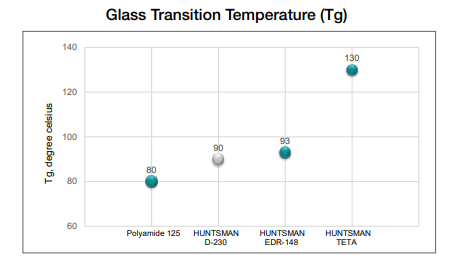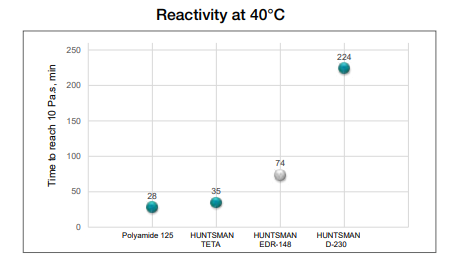Enhanced TDS
Identification & Functionality
- Base Chemicals Functions
- Blend
- No
- CASE Ingredients Functions
- Chemical Family
- Composite Materials Functions
- Industrial Additives Functions
- Plastics & Elastomers Functions
- Single Ingredient
- Yes
- Technologies
- Product Families
- Chemical Structure

Features & Benefits
- Base Chemicals Features
- CASE Ingredients Features
- Labeling Claims
- Materials Features
- Benefits
- Can be formulated to cure at room temperature
- Rapid cure at elevated temperatures
- Excellent thermal shock resistance in cured epoxies
- Low viscosity – Used as a reactive diluent in epoxy formulations
- High purity – Suitable as a molecule for synthesis of high-purity chemicals / intermediates
- High reactivity – Provides fast cure in epoxy adhesives
- Flexible and hydrophilic – Used as a monomer in polyamide applications instead of ethylene amines
- Thermal shock resistant – Suitable for epoxy electronic encapsulation, increasing life cycle of devices
- EHS profile – Not listed as a substance of very high concern
Applications & Uses
- Adhesive & Sealant End Applications
- Applicable Processes
- Base Chemicals End Uses
- Compatible Polymers & Resins
- Industrial Additives End Use
- Plastics & Elastomers Processing Methods
- Markets
- Applications
Properties
- Physical Form
- Soluble In
Regulatory & Compliance
Technical Details & Test Data
- Formulation Guide

Figure 1: Glass Transition Temperature of JEFFAMINE® EDR-148 amine versus other amines, fully cured with standard epoxy resin

Figure 2: Reactivity of JEFFAMINE® EDR-148 amine versus other amines cured with standard epoxy resin. Rheometer (1 mm layer, shear rate 1/15 s)
Storage & Handling
- Storage and Handling Information
Materials of Construction
At temperatures of 75-100°F (34-38°C)
Tanks : Carbon steel
Lines, valves : Carbon steel
Pumps : Carbon steel
Heat exchange Surfaces : Stainless steel
Hoses : Stainless steel, polyethylene, polypropylene, and TEFLON®
Gaskets, packing : Polypropylene or TEFLON® (elastomers such as neoprene, Buna N, and VITON® should be avoided)
Atmosphere : Nitrogen or dry air
At temperatures above 100°F (38°C)
Tanks : Stainless steel or aluminum
Lines, Valves : Stainless steel
Pumps : Stainless steel or Carpenter 20 equivalent
Atmosphere : Nitrogen- Handling Precaution
Mandatory and recommended industrial hygiene procedures should be followed whenever our products are being handled and processed.
- Storage Conditions
- JEFFAMINE® EDR-148 amine may be stored under air at ambient temperatures for extended periods. A nitrogen blanket is suggested for all storage, however, to reduce the effect of accidental exposure to high temperatures and to reduce the absorption of atmospheric moisture and carbon dioxide. It should be noted that pronounced discoloration is likely to occur at temperatures above 140°F (60°C), whatever the gaseous pad.
- Cleaning of lines and equipment containing JEFFAMINE® EDR-148 amine can be accomplished using warm water and steam. In the event of spillage of this product, the area may be flushed with water. The proper method for disposal of waste material is by incineration with strict observance of all federal, state, and local regulations.
Other
- Appearance
- Colorless to pale yellow liquid with slight haze permitted
- Chemical Properties
Value Units Test Method / Conditions Amine Hydrogen Equivalent Weight 37.0 g/eq g/eq Amine Value 12.7 - pH 11.6 - - Physical Properties
Value Units Test Method / Conditions Density 0.998 g/mL g/mL At 25°C Flash Point 129.0 °C °C Pensky-Martens Closed Cup (PMCC) Molecular Weight approx. 148.0 g/mol g/mol Viscosity 8.0 cSt cSt
